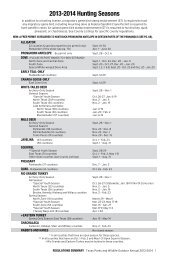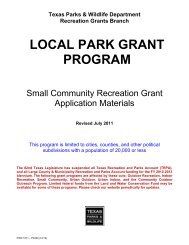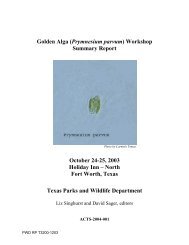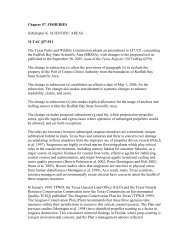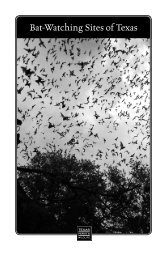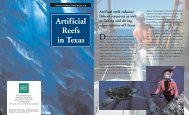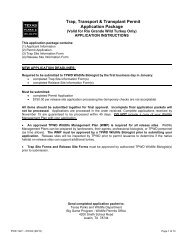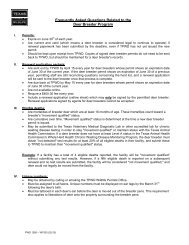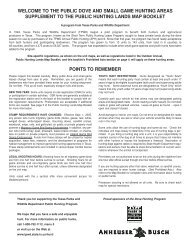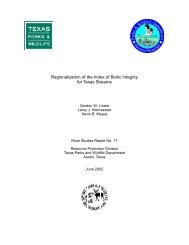1-1 Appendix 1 Responses to survey questions administered to ...
1-1 Appendix 1 Responses to survey questions administered to ...
1-1 Appendix 1 Responses to survey questions administered to ...
You also want an ePaper? Increase the reach of your titles
YUMPU automatically turns print PDFs into web optimized ePapers that Google loves.
• Weakness: TPWD has preferred <strong>to</strong> focus on specific species rather than<br />
assemblages of species within specific ecosystems, particularly opting <strong>to</strong> dodge<br />
threats posed by invasive exotics and issues that may challenge popular notions or<br />
generate critical information.<br />
• Our greatest weakness is a relatively poor habitat database and little desire <strong>to</strong><br />
elevate habitat data <strong>to</strong> a level of importance equal <strong>to</strong> fish population data.<br />
• The greatest weakness is that our district staff have so many reservoirs within<br />
their districts that most are not sampled annually, and that logistically-achievable<br />
sampling efforts may not ensure the degree of precision our staff would hope <strong>to</strong><br />
achieve. Of course, this is common <strong>to</strong> virtually all state agencies)<br />
• Weakness: Many times additional sampling is required <strong>to</strong> collect adequate<br />
sample numbers.<br />
• I think the greatest weakness is the sampling procedures are <strong>to</strong>o random <strong>to</strong><br />
adequately sample each species. Fish are not randomly distributed in a reservoir.<br />
At different times of the year they are usually concentrated in some area of the<br />
reservoir. Our sampling is somewhat stratified, but not enough. Many times we<br />
sample a certain species in an area of the lake where there is very little possibility<br />
of them being there. For instance a sample site is randomly picked that is a sandy<br />
or silt shoreline where we would catch very few largemouth bass. To me it makes<br />
more sense <strong>to</strong> identify areas of the reservoir where habitat is suitable for<br />
largemouth bass and then randomly select a number of stations <strong>to</strong> sample the<br />
largemouth bass population. It would save time because you would need fewer<br />
stations <strong>to</strong> get enough largemouth bass <strong>to</strong> adequately describe the population. If<br />
you use completely random stations then you will have <strong>to</strong> sample a lot more<br />
stations as pointed out by Dumont and Schlechte in “ Use of Resampling <strong>to</strong><br />
Evaluate a Simple Random Sampling Design for General Moni<strong>to</strong>ring of Fishes in<br />
Texas Reservoirs” (North American Journal of Fisheries Management 24:408-<br />
416, 2004. I have the same concerns with crappie. Based on past experience<br />
crappie are found in specific habitats in the fall, when we sample for them. Gill<br />
netting has similar limitations also.<br />
• Weakness = Random sampling on large reservoirs with limited quality habitat for<br />
certain species results in sampling locations that generally don't collect any of the<br />
target species (e.g., electrofishing for largemouth bass on bare mud flats with no<br />
vegetation). Also, random sampling for crappie results in very low catches<br />
because net locations are not in the best locations <strong>to</strong> catch crappie. Manpower<br />
would be better used if trap net locations could be selected by district biologists<br />
and used consistently from year <strong>to</strong> year. In addition, our standardized assessment<br />
procedures require us <strong>to</strong> trap net for crappie at least every 4 years. In some<br />
reservoirs, the crappie population is of very low abundance, but we are required <strong>to</strong><br />
sample them. For example, a trap net <strong>survey</strong> earlier this week did not catch a<br />
single crappie. This activity required about 12 man-hours when the time could<br />
have been spent better someplace else.<br />
• Weakness: <strong>to</strong>tally random sampling often leaves managers with <strong>to</strong>o small of a<br />
sample size <strong>to</strong> calculate important parameters.<br />
• Weakness=Total random sampling station selection design.<br />
2-29



